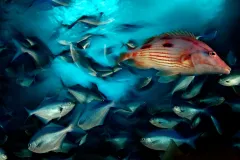Behind the Photo: The Primal Ocean

A few years ago, I was in New Zealand photographing a story about the value of marine reserves (a type of marine protected area). My last location was a place called the Poor Knights Islands, a spectacular group of small, rocky islands off the North Island of New Zealand, which had been fully protected as a no-take zone in the 1980’s.
One afternoon I was invited to have tea with an old-time diver named Wade Doak, who was somewhat of a legend in those parts. Over tea, Wade told me that he believed the marine life was better at Poor Knights today than when he was diving there in the 1950’s.
Everywhere I travel I am told, “You should have been here ten years ago, there were more fish.” But I found myself in a place that is actually better today than it was sixty years ago, simply because they left it alone thirty years ago. So I wanted to make a picture that I envisioned as the “primal ocean” that spoke to this resilience. I wanted it to be a picture that might give a feeling for how the ocean looked hundreds of years ago to instantly show readers the value of conservation.
The following morning was windy, overcast and gray and the boat captain suggested we not go out to sea. But the conditions didn’t seem unworkable, so I pushed to get offshore. Lying underwater at the mouth of a cavern, I was surrounded by schools of fish and mesmerized by the multitude of life. Spying a red pigfish darting through the school of blue mao-mao frequently, I adjusted my camera’s settings in hopes of creating a dream-like image. As the school swirled around me, I experimented with the movement and mixing light, releasing the shutter at those fleeting moments when gesture and grace blended together.
Back on the boat, I huddled over my camera housing with a towel draped over my head to block the sun and stared at the tiny images on the camera’s LCD playback. Among the many misses was a single, perfect frame, the picture I had in my mind’s eye before entering the water that day. It was the image of a once and future ocean; a sea of abundance that had been restored because of conservation.

